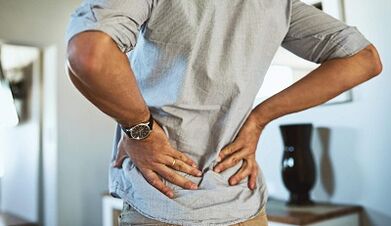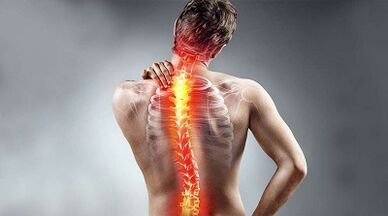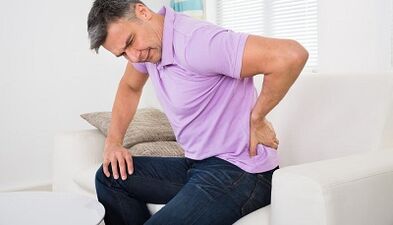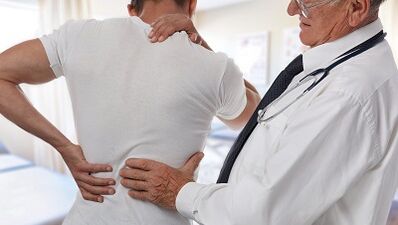
Back pain can occur at any age, but is more common between 35 and 55 years.Spine pain is associated with bones, muscles, vertebrae discs, ligaments, tendons and nerves.
Spinal pain can be caused by the internal organs of the vertebrae, spinal cords and nerves, back muscles, internal organs, abdominal and pelvic areas.In addition, aortic diseases, chest tumors and inflammation of the spine may be caused by the upper back of the back.
Risk factors
The presence of risk factors increases the likelihood of the state.For example, obesity significantly increases the risk of second type of diabetes.
The following factors are associated with an increase in the risk of back pain.
- office work;
- work related to constant stress;
- Pregnancy - pregnant women often suffer pain in the spine;
- sedentary lifestyle;
- circle;
- depression;
- obesity/overweight;
- smoking;
- heavy physical exercises;
- Hard physical work.
Signs and symptoms of back pain
The symptom is what the patient feels while the doctor may notice the signal.For example, pain is a symptom while the rash is a sign.
The main symptom of spine pain is pain in any part of the back.Occasionally, pain extends to the bottom and legs, or shoulders and arms.
Contact your doctor immediately if the pain in the spine is accompanied by any of the following signs:
- weight loss;
- high temperature (fever);
- Back pain does not relieve after rest;
- painful pain;
- painkiller pain under the knees;
- presence of fresh spine injury;
- urine incontinence (even a small part);
- Difficulties with urination - urine is difficult;
- stool incontinence - loss of control over the interruption process;
- numbness in the genitals;
- numbness in the anus;
- Numbness in the bottom.

Apply on the advice of a specialist if you are one of these groups:
- People under 22 or over 55 years of age;
- patients who have been taking steroids for several months;
- cancer patients;
- patients with cancer once;
- Patients with low immunity.
The causes of back pain
The human spine is a complex structure consisting of muscles, ligaments, tendons, discs and bones.The discs between the vertebrae are located between the pair of each vertebrae and act as friction dampers.Problems with any of these ingredients can lead to pain in the spine.In some cases, the causes of the pain cannot be determined.
Stretching
The most common causes of spine pain are as follows:
- stretched muscles;
- stretched tapes;
- It is difficult to raise the object in the wrong pose;
- lifting an too difficult object;
- the result of sharp and embarrassing movement;
- muscle spasm.
Structural problems
The following structural problems can cause pain in the spine:
- Protection of the intervertebral disk.Fracture of the exterior vagina of the disk leads to swelling of its inner contents outward.This nerve and, as a result, can lead to pain;
- The intervertebral disk hernia- stabbing the inner content of the large disc;
- sciatica- acute and shooting pain that radiates to the bottom and the back of the leg caused by the protrusion or hernia of the intervertebral disc, the nerve compression;
- arthritis- Patients with osteoarthritis generally experience problems with joints in the thighs, lumbar spine, knees and hands.In some cases, the spinal canal stenosis may occur as the space around the spinal cord is narrowed;
- The abnormal bend of the spine- If the spine is inclined in an unusual way, the patient is more likely to suffer from the pain of the spine.An example of an abnormal bend is the skoliosis in which the spine is inclined to the side;
- osteoporosis- The bones, including the vertebrae, become fragile and porous, leading to their fragility.

Below are some other reasons in the spine:
- The ponytail syndrome- The ponytail is a bunch of nerve roots into which the spinal cord branching.People with ponytail syndrome feel dull pain in the lumbar spine and buttocks.The sensitivity of the buttocks, genitals, thighs may also be lost.Occasionally, people with ponytail syndrome suffer from urinary and/or stools;
- spine cancer- the tumor in the spine can squeeze its nerve, which leads to pain;
- Spinal infection- If the patient has a high body temperature and has a painful hot area at the back, this may indicate the spine infection;
- Other infections- inflammation of the pelvic organs in women, as well as infections of bladder and kidneys back pain;
- sleep disorders- people with sleep disorders often suffer pain in the spine relative to the population;
- shingles- an infection that can affect the nerves;
- Inappropriate mattress- If the mattress does not support certain parts of the body and does not ensure its back position, there is a risk that there is pain in the spine.
Spinal pain can also be caused by certain movements or body positions, such as prolonged driving, cough and so on.
What to do if the back hurts
If you experience pain in the spine for several days, the following tips will help you reduce pain and discomfort and accelerate healing:

- Remain active as much as possible;
- If necessary, use the painkillers -number number;
- Use warm and cold compressions.A bottle of hot water and a bag of frozen vegetables are made.
Even though it is difficult to stay in pain, it is difficult to stay, try not to lose your heart.This accelerates the healing process.
With longer pain in the spine, which does not pass within six weeks, you should seek medical attention.The doctor compiles a medical history, examines it and directs it to further studies if necessary.The doctor may prescribe radiography on suspicion of suspected suspicion of suspicion of a problem with a bone system or osteoarthritis, CT (computer tomography) or MRI (magnetic resonance tomography) or other problems with soft tissue or nerves.In such a situation, MRI is the best choice.The doctor may also advise you to pass some laboratory tests or measure the electrical activity of the nerves (EMG).
After the diagnosis, the doctor prescribes treatment.In most cases, there is quite a conservative treatment that may include:
- Special exercises;
- reflexology;
- spine extensions;
- massage.
In severe cases, the issue of operation can be raised.The surgeon will help you choose the right method and give advice on possible complications.Sometime after surgery, university treatment of the spine is recommended sometime.Keep in mind that the spinal operations are quite dangerous as the area of operation is located in the immediate vicinity of the nerves.
















































